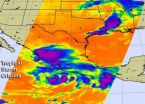(Press-News.org) PROVIDENCE, R.I. - Researchers from The Miriam Hospital have found that adding evidence-based weight loss strategies to a statewide wellness campaign improves weight loss outcomes among participants. The study and its findings are published online in advance of print in the American Journal of Public Health.
Lead researcher Tricia Leahey, Ph.D., and her colleagues chose to conduct a study among participants in Rhode Island's annual, three-month statewide health campaign. Called Shape Up Rhode Island (SURI), the campaign was founded in 2005 and takes a grass roots approach in reaching Rhode Islanders.
Leahey says, "Given their reach, statewide wellness initiatives like Shape Up Rhode Island have the potential to improve health in large numbers of individuals; however, weight losses produced are typically modest. Thus, we examined whether adding evidence-based weight loss strategies to a statewide wellness campaign improves weight loss outcomes. We found that such an approach was effective and could, therefore, significantly improve the public health impact of these campaigns."
As a researcher with the Weight Control and Diabetes Research Center of The Miriam Hospital, Leahey led the randomized trial. For the study, 230 participants were recruited from the 2011 SURI campaign and were randomly assigned to one of three groups: the standard SURI program, the SURI program plus an evidence-based internet behavioral weight loss program, or SURI plus the evidence-based internet program with the option to attend weekly group weight loss sessions.
At the end of three months, weight loss differed among all three groups. Both of the evidence-based approaches resulted in a significantly greater weight loss compared to the SURI campaign alone. In addition, the evidence-based programs increased the percentage of individuals who achieved a 5 percent, or clinically meaningful, weight loss. Among those who were using the evidence-based internet program in addition to SURI, 42 percent of the participants achieved a 5 percent weight goal; as did 54 percent of the group who also attended the weekly group sessions. Among participants using SURI alone, only 7 percent achieved a 5 percent weight loss.
Of the findings, Leahey says, "We show that adding evidence-based behavioral weight loss strategies to a statewide campaign improves the magnitude of weight loss and increases the percentage of individuals who achieve a clinically meaningful weight loss (i.e., a weight loss that is associated with reduced risk for diabetes and other health problems) six-fold. Moreover, the internet-based approach (i.e., that did not involve weekly group sessions) was the most cost effective."
Leahey concludes, "The results of this study are important because they show that incorporating evidence-based strategies into wide-reaching wellness initiatives could have a meaningful impact on the health of our communities."
INFORMATION:
Leahey's primary affiliation is The Miriam Hospital. Funding for this study was provided by the National Institutes of Health. Leahey is also an assistant professor (Research) of Psychiatry and Human Behavior) at The Warren Alpert Medical School of Brown University. Other researchers in the study include J. Graham Thomas, Ph.D., Joseph Fava, Ph.D., Katie Krupel, M.S. and Rena Wing, Ph.D., all of The Miriam Hospital and Alpert Medical School; Leslee Subak, M.D. and Michael Schembri, B.S., of the University of California San Francisco;; Rajiv Kumar, M.D., of Shape Up Rhode Island; Brad Weinberg, M.D. of Blueprint Health, Inc.
About The Miriam Hospital
The Miriam Hospital is a 247-bed, not-for-profit teaching hospital affiliated with The Warren Alpert Medical School of Brown University. It offers expertise in cardiology, oncology, orthopedics, men's health, and minimally invasive surgery and is home to the state's first Joint Commission-certified Stroke Center and robotic surgery program. The hospital, which received more than $23 million in external research funding last year, is nationally known for its HIV/AIDS and behavioral and preventive medicine research, including weight control, physical activity and smoking cessation. The Miriam Hospital has been awarded Magnet Recognition for Excellence in Nursing Services four times and is a founding member of the Lifespan health system. Follow us on Facebook, Twitter (@MiriamHospital) and Pinterest.
Miriam Hospital study shows how to make statewide health campaigns more effective
2014-06-10
ELSE PRESS RELEASES FROM THIS DATE:
NASA sees Tropical Storm Christina's birth and severe weather in US South
2014-06-10
NASA's Aqua satellite captured a picture of newborn Tropical Storm Cristina on June 10, marking the birth date of the Eastern Pacific Ocean's third tropical storm of the season. The same image showed the severe weather affecting the south central U.S.
Although not at the coastline, the National Hurricane Center said that Cristina is near enough to cause dangerous surf conditions.
According to the National Hurricane Center (NHC), swells generated by Cristina are affecting portions of the south-central coast of western Mexico. These swells will likely continue through ...
NASA-NOAA's Suomi NPP satellite spots Arabian Sea tropical cyclone
2014-06-10
Tropical Cyclone 02A formed in the Arabian Sea as NASA-NOAA's Suomi NPP satellite passed overhead and captured a visible photo of the storm, spotting strongest storms south of its center.
On June 10 at 08:21 UTC (4:21 a.m. EDT), when Suomi NPP passed over 02A, the Visible Infrared Imaging Radiometer Suite (VIIRS) instrument aboard captured a visible image of the storm. VIIRS collects visible and infrared imagery and global observations of land, atmosphere, cryosphere and oceans.
In the image, Tropical Storm 02A appeared slightly elongated but satellite data shows that ...
NASA's SDO sees a summer solar flare
2014-06-10
The sun emitted a significant solar flare, peaking at 7:42 a.m. EDT on June 10, 2014. NASA's Solar Dynamics Observatory – which typically observes the entire sun 24 hours a day -- captured images of the flare.
Solar flares are powerful bursts of radiation. Harmful radiation from a flare cannot pass through Earth's atmosphere to physically affect humans on the ground. However, when intense enough, they can disturb the atmosphere in the layer where GPS and communications signals travel.
To see how this event may affect Earth, please visit NOAA's Space Weather Prediction ...
Inside the adult ADHD brain
2014-06-10
CAMBRIDGE, MA -- About 11 percent of school-age children in the United States have been diagnosed with attention deficit hyperactivity disorder (ADHD). While many of these children eventually "outgrow" the disorder, some carry their difficulties into adulthood: About 10 million American adults are currently diagnosed with ADHD.
In the first study to compare patterns of brain activity in adults who recovered from childhood ADHD and those who did not, MIT neuroscientists have discovered key differences in a brain communication network that is active when the brain is at ...
Mammography has led to fewer late-stage breast cancers, U-M study finds
2014-06-10
ANN ARBOR, Mich. — In the last 30 years, since mammography was introduced, late-stage breast cancer incidence has decreased by 37 percent, a new study from the University of Michigan Comprehensive Cancer Center finds.
The analysis takes into account an observed underlying trend of increased breast cancer incidence present since the 1940s, a sort of inflation rate for breast cancer.
Researchers looked at early-stage and late-stage breast cancer diagnoses between 1977-1979, before mammography became popular, and compared it to diagnoses between 2007-2009. Based on trends ...
A plan to share the carbon budget burden
2014-06-10
PROVIDENCE, R.I. [Brown University] — Climate change is an issue of urgent international importance, but for 20 years, the international community has been unable to agree on a coordinated way to reduce greenhouse gas emissions. In a "Perspective" piece published in the June issue of Nature Climate Change, J. Timmons Roberts, the Ittleson Professor of Environmental Studies and Sociology, proposes a four-step compromise toward emissions reduction that offers "effectiveness, feasibility, and fairness."
Their proposal comes as another major United Nations meeting on climage ...
Soldiers who kill in combat less likely to abuse alcohol
2014-06-10
WASHINGTON, D.C. (June 10, 2014)—It's no secret that combat experiences are highly stressful and can contribute to instances of post-traumatic stress disorder and depression among soldiers post-deployment. It also comes as no surprise that many soldiers afflicted with these conditions abuse alcohol in an attempt to self-medicate.
But new research coauthored by Cristel Russell, an associate professor of marketing with American University's Kogod School of Business, and researchers with the Walter Reed Army Institute of Research finds that the most traumatic of all combat ...
New biometric watches use light to non-invasively monitor glucose, dehydration, pulse
2014-06-10
WASHINGTON, June 9—Monitoring a patient's vital signs and other physiological parameters is a standard part of medical care, but, increasingly, health and fitness-minded individuals are looking for ways to easily keep their own tabs on these measurements. Enter the biometric watch.
In a pair of papers published in The Optical Society's (OSA) open-access journal Biomedical Optics Express, groups of researchers from the Netherlands and Israel describe two new wearable devices that use changing patterns of scattered light to monitor biometrics: one tracks glucose concentration ...
A life well spent: Consume now (in case you die early)
2014-06-10
PRINCETON, N.J.—You only live once. Carpe diem. You can't take it with you.
As often as we hear these clichés, they might include some real economic wisdom for some, according to research led by Princeton University's Woodrow Wilson School. The researchers argue in the Journal of Mathematical Economics that some people might want to spend more and work less – just in case their time runs out.
Marc Fleurbaey, the Robert E. Kuenne Professor in Economics and Humanistic Studies and professor of public affairs, and his collaborators – Marie-Louise Leroux from the University ...
Innovative millimeter wave communications to be demonstrated at London exhibition
2014-06-10
Wireless data connections that exploit millimetre wave radio spectrum (30GHz to 300GHz) are expected to be used in worldwide 5G networks from 2020. The University of Bristol's Communication Systems and Networks research group has partnered with Bristol start-up Blu Wireless Technology (BWT) to develop this technology and they will demonstrate their innovative work at the Small Cells World Summit in London this week [10-12 June].
Millimetre wave radios use much higher carrier frequencies than those in current systems, such as 4G and Wi-Fi. The University and BWT radios ...






